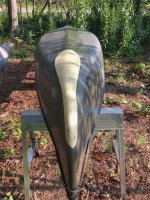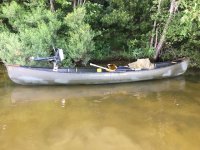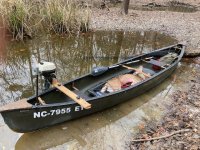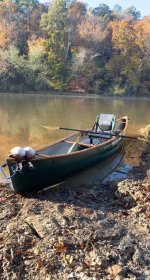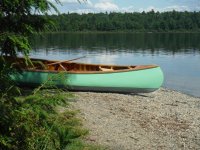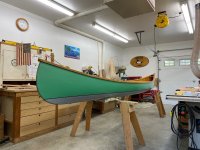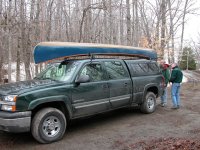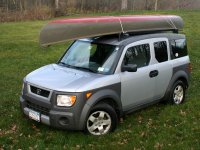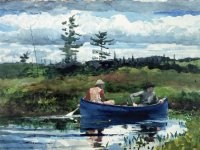Steve Sanford
Well-known member
Good morning, All~
This post may be "NDR" - because my latest canoe (I am inching toward 20 such vessels....) may get the "yacht" treatment rather than my default gunning boat treatment.
This was an impulse buy - which I came across on Facebook Marketplace. It was available about 10 miles from my Mom's house - and very close to where I use to live on Long Island. So, I coordinated a visit to my Mom (now age 96) to visit the canoe as well. As it happened, it was offered by another member of the LI Decoy Collectors Association - and said member - Mike Yannelli - had performed some beautiful work on the rails and decks. No structural problems, this 16-foot Explorer by Mad River Canoe Company needed only some cosmetic work on the exterior of the hull. So, it came back to my Mom's with 2 nice paddles.

It's first adventure was only about a 1/4 mile West from my boyhood home....but met my expectations...

A gorgeous vessel, the Explorer was quite different from any of my other canoes.

Whereas I typically hunt for canoes with traditional lines - recurved ends and flat floors - this boat is made for more challenging waters than beaver ponds and fairly flat rivers. She has bit of deadrise to her bottom.
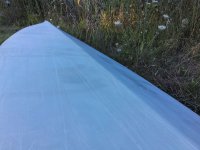
I have not measured the angle, but the shallow vee is nothing I have paddled before. I am thinking she will be very happy up on Lake Champlain (where we have a seasonal family camp.) Seas can get a bit lumpy there with a bit of a breeze.
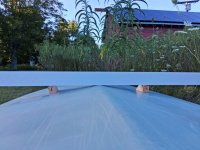
She seems to have just a bit of rocker - but I have not yet struck a line along her keel. The ends lift a bit - so she will not root when asked to turn.

The hull is 'glass (not the Kevlar or Royalex used in some later models) and the rails, decks, seats and yoke are all wood.

All the woodwork is either new or recently restored - and the interior needs only a bit of scrubbing.
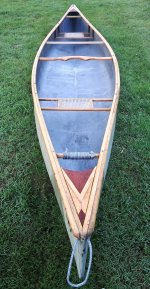
As you may have seen with most of my other canoes, I usually remove all or most of the aluminum and replace it with wood. This Indian River Canoe got such a treatment a few years ago. It lives on a local beaver marsh.
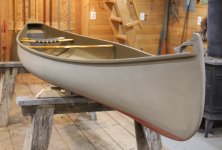
The ends are neither plumb nor recurved. Not sure of the proper descriptor - but I am thinking "cutaway" - or even "knockabout".... I'll bet Bob Welsh or Matt Mahoney can educate me on this point.
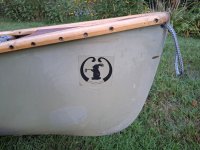
Waitsfield is in north central Vermont - home to the Mad River. The company was founded in 1971. Like so many companies, it later was moved and sold - and production of Mad River Canoes was suspended - in favor of the more popular kayaks and paddleboards et cetera. The Indian lore surrounding the "bunny" relates to its competence and confidence.
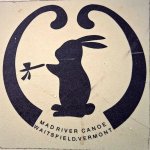
Mike replaced the original decks - which had rotted - with these beautiful and well-executed details.
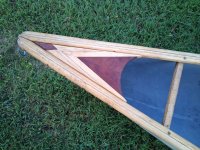
The seats and thwart are original and in fine condition.
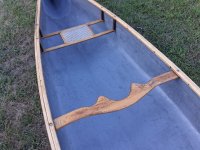
The plastic "wicker" insert seems healthy - not about to split as so many do. I think the hangers are new - thanks to Mike.
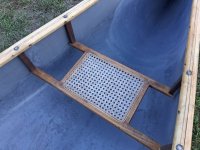
Mike replaced the rails with Paulownia - aka "Princess Tree" (after a Russian princess) and a relative of Catalpa and Trumpet Creeper. It is very light, somewhat rot/insect resistant - but not as stiff as the traditional White Ash rails. Mike builds surf boards - hence his familiarity with Paulownia.
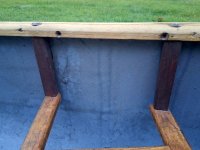
I am thinking Boston Whaler started the now-common practice of featuring the manufacturer prominently on hulls. It is not my cup of tea - and the words will not survive my re-painting. One of my favorite headlines from The Onion: "14-year-old collapses under weight of corporate logos"......

I will probably take my drawknife to the yoke - and scalp it to a more comfortable shape for my neck and shoulders.
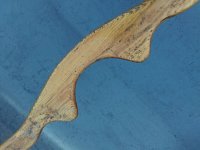
Mike added this extra thwart - to address the greater flex with the Paulownia rails. I will replace it with a length of White Ash - shaped in both plan and profile like a more traditional thwart.

I have yet to paddle this boat - but am intrigued by its history. I remember when they came on the market (1975) - and have always admired them. They have been called "the Volvo of canoes" - for their sensible, versatile design and sound construction. And, it was a 16-foot Mad River Explorer that was the first open canoe to successfully navigate/negotiate the Grand Canyon - in 1976. I need to learn more - and would welcome any experiences or perspective other Explorer owners wish to share.
BTW: I have not yet decided on the hull color - but it will not be Marsh Grass or Duckboat Drab. And, its bottom with be a contrasting hue. (This will be a Winter project.)
All the best,
SJS
This post may be "NDR" - because my latest canoe (I am inching toward 20 such vessels....) may get the "yacht" treatment rather than my default gunning boat treatment.
This was an impulse buy - which I came across on Facebook Marketplace. It was available about 10 miles from my Mom's house - and very close to where I use to live on Long Island. So, I coordinated a visit to my Mom (now age 96) to visit the canoe as well. As it happened, it was offered by another member of the LI Decoy Collectors Association - and said member - Mike Yannelli - had performed some beautiful work on the rails and decks. No structural problems, this 16-foot Explorer by Mad River Canoe Company needed only some cosmetic work on the exterior of the hull. So, it came back to my Mom's with 2 nice paddles.

It's first adventure was only about a 1/4 mile West from my boyhood home....but met my expectations...

A gorgeous vessel, the Explorer was quite different from any of my other canoes.

Whereas I typically hunt for canoes with traditional lines - recurved ends and flat floors - this boat is made for more challenging waters than beaver ponds and fairly flat rivers. She has bit of deadrise to her bottom.

I have not measured the angle, but the shallow vee is nothing I have paddled before. I am thinking she will be very happy up on Lake Champlain (where we have a seasonal family camp.) Seas can get a bit lumpy there with a bit of a breeze.

She seems to have just a bit of rocker - but I have not yet struck a line along her keel. The ends lift a bit - so she will not root when asked to turn.

The hull is 'glass (not the Kevlar or Royalex used in some later models) and the rails, decks, seats and yoke are all wood.

All the woodwork is either new or recently restored - and the interior needs only a bit of scrubbing.

As you may have seen with most of my other canoes, I usually remove all or most of the aluminum and replace it with wood. This Indian River Canoe got such a treatment a few years ago. It lives on a local beaver marsh.

The ends are neither plumb nor recurved. Not sure of the proper descriptor - but I am thinking "cutaway" - or even "knockabout".... I'll bet Bob Welsh or Matt Mahoney can educate me on this point.

Waitsfield is in north central Vermont - home to the Mad River. The company was founded in 1971. Like so many companies, it later was moved and sold - and production of Mad River Canoes was suspended - in favor of the more popular kayaks and paddleboards et cetera. The Indian lore surrounding the "bunny" relates to its competence and confidence.

Mike replaced the original decks - which had rotted - with these beautiful and well-executed details.

The seats and thwart are original and in fine condition.

The plastic "wicker" insert seems healthy - not about to split as so many do. I think the hangers are new - thanks to Mike.

Mike replaced the rails with Paulownia - aka "Princess Tree" (after a Russian princess) and a relative of Catalpa and Trumpet Creeper. It is very light, somewhat rot/insect resistant - but not as stiff as the traditional White Ash rails. Mike builds surf boards - hence his familiarity with Paulownia.

I am thinking Boston Whaler started the now-common practice of featuring the manufacturer prominently on hulls. It is not my cup of tea - and the words will not survive my re-painting. One of my favorite headlines from The Onion: "14-year-old collapses under weight of corporate logos"......

I will probably take my drawknife to the yoke - and scalp it to a more comfortable shape for my neck and shoulders.

Mike added this extra thwart - to address the greater flex with the Paulownia rails. I will replace it with a length of White Ash - shaped in both plan and profile like a more traditional thwart.

I have yet to paddle this boat - but am intrigued by its history. I remember when they came on the market (1975) - and have always admired them. They have been called "the Volvo of canoes" - for their sensible, versatile design and sound construction. And, it was a 16-foot Mad River Explorer that was the first open canoe to successfully navigate/negotiate the Grand Canyon - in 1976. I need to learn more - and would welcome any experiences or perspective other Explorer owners wish to share.
BTW: I have not yet decided on the hull color - but it will not be Marsh Grass or Duckboat Drab. And, its bottom with be a contrasting hue. (This will be a Winter project.)
All the best,
SJS
Last edited:


